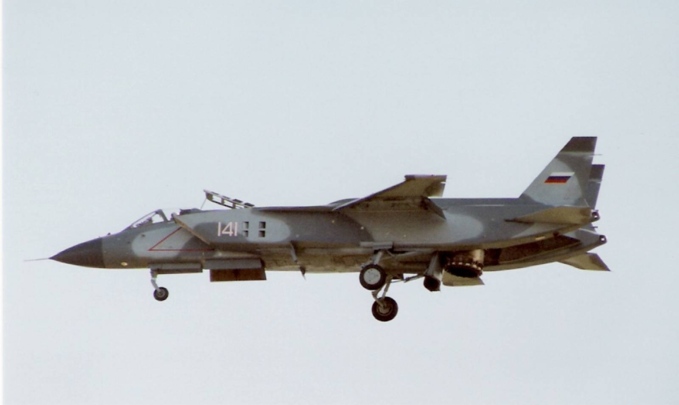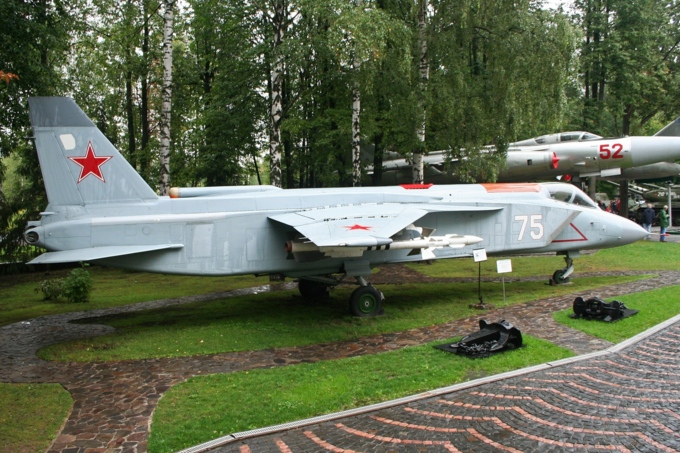The Yakolev Yak-141 was a prototype Soviet VTOL supersonic fighter designed as a successor to the Yak-38. While the subsonic “Forger” with limited payload and poor handling was more of a proof of concept than a serious combat aircraft for its time, the heavily evolved Yak-141 was a far more capable one. It was a much larger aircraft with refined aerodynamics and a monstrously powerful Tumansky R-79 turbofan primary engine. With modern avionics and long-range missiles at its disposal, the Yak-141 was poised to be a world-leading supersonic VTOL fighter and a strong asset for the Soviet Navy — however, the collapse and political issues of the USSR prevented the Yak-141 from entering serial production and operational service in real combat situations and operations.
Background
While the Yak-38 and its later modernised Yak-38M variant fulfilled the role of a fleet defence strike fighter for the Soviet navy, the aircraft were considered obsolete almost immediately due to the many shortcomings they had, such as a very poor range of less than 100 km, difficulty operating in hot weather, inability to operate at night due to lack of radar or advanced targeting systems, horrible controllability and manoeuvrability due to the heavy weight and high wing loading, and a small combat payload among other things.
As early as 1973, the AVMF and OKB-115, led by General Designer Aleksander Yakovlev, went back to the drawing board to create a new generation of VTOL fighters for the Soviet navy. The successor aircraft project outlined a set of requirements: the new aircraft had to be supersonic, incorporate an advanced fire control system and radar/sensor suite, allow for a larger range of operations, and include a larger array of weapons. At the time of the project, no aircraft like this existed in the world, and the only equivalent that came close was the French Dassault Balzac V prototype.
Design
This new aircraft would be designed around the new Soyuz-Tumansky R-79V lift/cruise afterburning turbofan, starting its life as the Yak-36P heavy VTOL naval interceptor. However, after substantial changes and almost a complete redesign of the aircraft resulting from reconsideration of the project requirements, the project would be redesignated as the Yak-41. In mid-1974, the Communist Party’s Central Committee and Council of Ministers would issue a directive for the development of a new Soviet VTOL fighter, officially kickstarting the project.
After many years of research and development, the design was finalised and submitted for review in June 1980. The design invoked many new technologies not yet standardised in the Soviet Union, such as composite materials and advanced radars. Many setbacks with the R-79V engine and the Phazotron S-41 radar development programs caused the development schedule of the Yak-41 to be delayed by a few years.
Flight testing
In 1983, the first static (non-flying) prototype was completed, and static ground testing commenced until the radar, engine, and fly-by-wire/power-by-wire systems were completed. The first flying prototype was soon completed and on 9 March 1987 performed its maiden flight. Many of the important systems such as the S-41 radar and the other important avionics were still not completed fully, and would be incorporated later into the second flyable prototype which was completed in 1989.
The second prototype was a more definitive “Yak-41” prototype, this time including most of its avionics and fire control system, such as the Zhuk S-41M radar which was completed by now, and would go as far as to mount mock-up missiles and weapons for flight testing and “simulated” firing during trials. The most notable missing piece of avionics was the IRST system, which was ready to be installed when completed as shown by the cut-out for it on top of the nose on the second flying prototype.
The Yak-41 showed great promise, and at this stage of flight testing started setting many world records. To keep its development and true identity secret, the Soviet Union registered the aircraft as the “Yak-141” instead of Yak-41 with international record keeping agencies, hence where the 141 designation comes from. The Yak-41 program was proceeding smoothly at that point, with many flight tests scheduled and performed successfully over the next few years. Most notably, by 1991 the Yak-41s had flown to Severomorsk-1 airbase and successfully performed carrier trials and testing, including both VTOL and STOL operations from the carrier Baku (later renamed Admiral Gorshkov), in anticipation of future service deployment aboard the new and upcoming Type 1143.5 carrier Tbilisi (later renamed to Admiral Kuznetsov) once the aircraft was accepted into service.
Cancellation
However, as promising as the aircraft was, the program was ultimately terminated in 1992 due to lack of funding after the collapse of the USSR. The Yakovlev design bureau then started trying to find foreign investors and buyers for the aircraft. Shortly after, a very unlikely foreign investor appeared at Yakovlev’s doorstep, as Lockheed Corporation started negotiations for further funding more Yak-141 prototypes. The two flying prototypes, White 75 and White 77, would both be repainted into identical “White 144” liveries, and the two static non-flying prototypes would be cannibalised for spare parts before being scrapped to ensure that public display of the Yak-41 was flawless.
Legacy
The first public appearance of the Yak-41 occurred famously at the 1992 Farnborough Airshow in the United Kingdom. However, the Yak-41s would be banned from performing vertical take-offs after a few days at the airshow due to “excessive wear to the runway”, a testament to the powerful thrust from the engines in vertical flight.
Shortly after, Yakovlev had announced that they had successfully reached an agreement with Lockheed for $4 million USD in funding for two more flying prototypes, a twin-seat trainer prototype, and a single static (non-flying) testbed to test improvements in avionics. The partnership had actually begun almost immediately after the USSR had collapsed, but was not revealed publicly by Yakovlev and Lockheed until 6 September 1992. It is widely believed that many of the technological advancements from the Yak-41 program would be directly applied by Lockheed through their partnership to the upcoming X-35 prototype in the Joint-Strike Fighter program, most notably the later VTOL F-35B variant, which shares many basic features with the Yak-41.
The two flyable prototypes, now no longer flyable, would be exhibited as static ground displays at the 1993 Moscow airshow. Shortly after, the two prototypes would undergo cosmetic restoration before being placed in museums for permanent display. The first flyable prototype retained its post-Soviet “White 141” livery, and is permanently displayed at the Central Air Force Museum at Monino. The second prototype was re-painted into the “White 75” livery originally used by its sister aircraft (the first prototype), and placed in the Technical Museum, Arkhangelskoye, Moscow.
Image credit: Alan Wilson (Flickr) / CC BY-SA 2.0
Bibliography
- Gordon, Yefim. Yakovlev Yak-36, Yak-38 & Yak-41: The Soviet “Jump Jets.” Midland Publishing, 2008.
- Gordon, Yefim, and Gunston, Bill. “Yakovlev’s Experimental VTOLs”. Soviet X-Planes p.213-215. Midland, Hinckley, 2000.
- Gordon, Yefim. Yakovlev Aircraft since 1924. Putnam Aeronautical Books, London, 1997.





